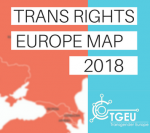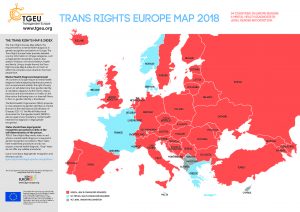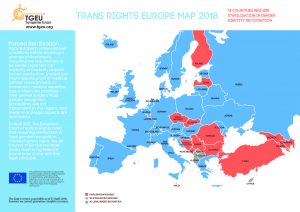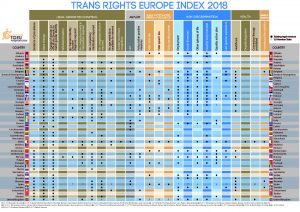
About the Trans Rights Europe Map & Index
The Trans Rights Europe Map reflects the requirement for a mental health diagnosis in gender recognition procedures in Europe. The Trans Rights Europe Index provides detailed country information in 25 legal categories, such as legal gender recognition, asylum, bias speech/ violence, non-discrimination, health and family.
Using a simple format, the Trans Rights Europe Map & Index do not claim to reflect the complex social situations trans people face.
Mental Health Diagnosis Requirement
34 countries in Europe require a mental health diagnosis before adapting identity documents.
Such a requirement violates the right of every person to self-determine their gender identity. A mandatory diagnosis further drives stigma, exclusion and discrimination as it relies on the false notion that being trans is a (mental) illness. In fact, no gender identity is disordered.
The World Health Organisation (WHO) proposes to stop categorising gender identities as mental illnesses in the International Classification of Diseases (ICD-11). The World Professional Association for Transgender Health (WPATH) advises against any mandatory mental health treatment or diagnosis in legal gender recognition.
States should base legal gender recognition procedures solely on the self-determination of the person.

TGEU’s Trans Rights Map marks states in red where a mental health diagnosis is required in gender recognition procedures. “Blue” states have established procedures and do not request a mental health diagnosis. “Brown” states do not offer any reliable procedures.
Learn more about legal gender recognition and what you can do improve it.
Forced Sterilisation
14 countries in Europe require sterility in legal gender recognition.
Many European states impose conditions before enabling a change of documents, including the requirement to be sterile. Legal text can explicitly or implicitly request forced sterilisation. Implicit law might require proof of medical gender reassignment, or mandatory medical expertise that is often only provided after genital surgery. Most gender recognition procedures are not transparent in this regard, and medical and legal aspects are intertwined.
In April 2017, the European Court of Human Rights ruled that requiring sterilisation in legal gender recognition violates human rights law. All Council of Europe member states must bring relevant procedures in line with this legal principle.

Trans Rights Europe Index
The Trans Rights Europe Index provides detailed country information in 25 legal categories, such as legal gender recognition, asylum, bias speech/ violence, non-discrimination, health and family.
Using a simple format, the Trans Rights Europe Map & Index do not claim to reflect the complex social situations trans people face.
See the criteria used in all categories.

This year, the Index has five new categories indicating legal protection in the areas of:
- Self-determination in legal gender recognition
- Recognition of gender non-binary identities
- Discrimination in Healthcare
- Depathologisation of trans identities while ensuring stigma-free access to specific care
- Recognition of trans parenthood
Fast Facts Trans Rights Europe Index
Legal Gender Recognition (LGR)
Procedures exist in: 41 countries
Out of these:
- 31 have legal certainty
- 10 have no legal certainty (procedures only, but no law)
- 34 request a diagnosis
- 7 request NO diagnosis
- 5 are based on self-determination
- 14 demand sterility
- 27 demand NO sterility
- 27 require medical interventions
- 21 request a divorce
- 20 request NO divorce
- 33 have age barriers
- 8 have NO age barriers
- 1 offer recognition for non-binary identities
within the EU:
- 27 countries enable LGR
- 7 demand sterility
- 20 demand a mental health diagnosis
- 11 demand divorce
- 21 have an age barrier
Asylum
- 16 countries offer international protection on grounds of gender identity
- 13 out of these are EU member states
- 15 EU-countries offer NO international protection on grounds of GI (and are thus violating EU law)
- 13 countries have positive measures (policies) in place
Non-Discrimination
- 27 countries protect against discrimination in employment
- 10 EU member states do not protect against discrimination in employment (and are thus violating EU law)
- 22 countries protect against discrimination in access to goods & services
- 14 EU member states do not protect against discrimination in goods & services (and are thus violating EU law)
- 22 countries protect against discrimination in other spheres of life
Bias-motivated Crime
Laws exist in: 13 countries
- 5 countries have positive measures (policies) in place combating bias-motivated crime and hate speech
Healthcare
- 18 offer protection against discrimination in healthcare
- 1 have depathologised trans identities
- 2 prohibit conversion therapy
Family
- 4 recognise trans parenthood
Equality Body Mandate
Equality Bodies in 25 countries have an Equality Body mandate inclusive of gender identity
- 11 EU member states have no equality body mandated to work on gender identity
Disclaimer:
Data provided is as correct as possible on 21 April 2018, however, we cannot guarantee complete accuracy.
In collaboration with:
The Trans Rights Europe Map & Index has been developed in cooperation with ILGA-Europe.